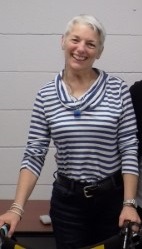Hamilton Support Group Leader Laurie Bell steps down as the Leader of the Hamilton Support Group. Here is Laurie’s story.

I was diagnosed in 1989. At that time, I was 36 years old, working full time with two sons (ages eleven and nine). I had a great job that was physically taxing but making better money than I had ever expected to. I was not a college graduate. I made good wages, had benefits and a pension plan…good stuff for a working Mom.
I had ear aches, jaw aches, head aches. I had been seeing a chiropractor, but he could do nothing about the neck pain. I always carried Extra Strength Tylenol in my purse. I went to specialists and pestered my dentist, but to no avail.
I was at a wedding in September of that year, and I was keeping an ice pack on my neck by this time. My sister, who was a Maid of Honour at the wedding, advised me to see her neurologist. My sister had been living with generalized dystonia since she was 5 years old. Fortunately, she knew the symptoms.
So, I went to the neurologist, who, after a quick physical exam in her office, diagnosed me with Cervical Dystonia. I took the medication she prescribed and she said I’d be back to work in six weeks. Six week later I was in a wheel chair, so I stopped taking the pills and went to a different neurologist. By this time, I was grappling with debilitating migraines and a neck that was frozen in place. I could not drive.
At the time, there was a fledgling Dystonia Foundation that was heavy on the workload and very light on information. We had no way of connecting with others, no way to learn more about the ways my life would change. I only had my sister and her experience to draw on.
In 1993 I had surgery in Montreal, called selective denervation. Selective denervation surgery involves severing the nerve that carries the incorrect messages between the affected muscle and the brain. It did not straighten my neck, but released my right sternocleidomastoid muscle (SCM) from its spasm, thus loosing all neck support on the right side. I did gain flexion and have had no migraines since this procedure.
The change in my neck posture caused my body to bend extremely, to compensate for the crooked world my eyes saw, and after years of walking /standing bent to the left, I developed a severe scoliosis (abnormal curvature of the spine). I began a physiotherapy regimen in 2006.
Anyone can manifest dystonic symptoms, any race, any age or gender. The condition does not discriminate. My Neurologist now diagnoses me as having segmental dystonia, as my facial spasms and hand tremor are involved. There are several treatments available. Sadly, none of these treatments are cures.
I personally use a few pharmaceuticals – but nothing with codeine since I began my physiotherapy routine. My pain levels are much lower, and my body strength has vastly improved. My mobility continues a downhill slide, for which we have no practical answer. It could be postural; it is NOT dystonic. It is a severe and constant worry. I use a lot of yoga. I modify my postures and thankfully my instructor is good with that.
My physiotherapy routine includes resistance training, balance work, weight lifting, and core strengthening. Hamstring stretches, hip flexor stretches, some manual neck stretches and massage are also part of my routine.
Stress and fatigue are definite factors in the symptoms gaining severity. This is one thing that all dystonia patients I have met have in common. That, and a dream of a cure.
-Laurie Bell
